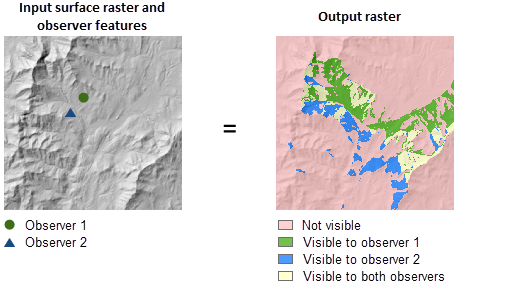| Label | Explanation | Data Type |
Input raster | The input surface raster. | Raster Layer |
Input point observer features | The point feature class that identifies the observer locations. The maximum number of points allowed is 16. | Feature Layer |
Z factor (Optional) | The number of ground x,y units in one surface z-unit. The z-factor adjusts the units of measure for the z-units when they are different from the x,y units of the input surface. The z-values of the input surface are multiplied by the z-factor when calculating the final output surface. If the x,y units and z-units are in the same units of measure, the z-factor is 1. This is the default. If the x,y units and z-units are in different units of measure, the z-factor must be set to the appropriate factor or the results will be incorrect. For example, if the z-units are feet and the x,y units are meters, use a z-factor of 0.3048 to convert the z-units from feet to meters (1 foot = 0.3048 meter). | Double |
Use earth curvature corrections (Optional) | Specifies whether correction for the earth's curvature will be applied.
| Boolean |
Refractivity coefficient (Optional) | The coefficient of the refraction of visible light in air. The default value is 0.13. | Double |
Output above ground level raster (Optional) | The output above ground level (AGL) raster. The AGL result is a raster where each cell value is the minimum height that must be added to an otherwise nonvisible cell to make it visible by at least one observer. Cells that were already visible will have a value of 0 in this output raster. | Raster Dataset |
Return Value
| Label | Explanation | Data Type | Output raster | The output raster. The output identifies exactly which observer points are visible from each raster surface location. | Raster |
